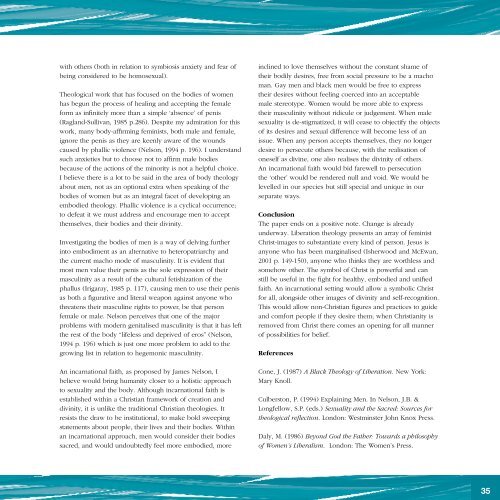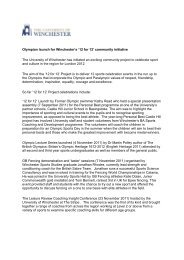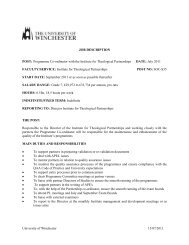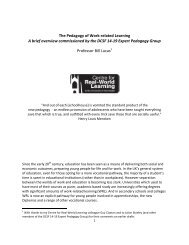alfred 2 - University of Winchester
alfred 2 - University of Winchester
alfred 2 - University of Winchester
Create successful ePaper yourself
Turn your PDF publications into a flip-book with our unique Google optimized e-Paper software.
with others (both in relation to symbiosis anxiety and fear <strong>of</strong><br />
being considered to be homosexual).<br />
Theological work that has focused on the bodies <strong>of</strong> women<br />
has begun the process <strong>of</strong> healing and accepting the female<br />
form as infinitely more than a simple ‘absence’ <strong>of</strong> penis<br />
(Ragland-Sullivan, 1985 p.286). Despite my admiration for this<br />
work, many body-affirming feminists, both male and female,<br />
ignore the penis as they are keenly aware <strong>of</strong> the wounds<br />
caused by phallic violence (Nelson, 1994 p. 196). I understand<br />
such anxieties but to choose not to affirm male bodies<br />
because <strong>of</strong> the actions <strong>of</strong> the minority is not a helpful choice.<br />
I believe there is a lot to be said in the area <strong>of</strong> body theology<br />
about men, not as an optional extra when speaking <strong>of</strong> the<br />
bodies <strong>of</strong> women but as an integral facet <strong>of</strong> developing an<br />
embodied theology. Phallic violence is a cyclical occurrence;<br />
to defeat it we must address and encourage men to accept<br />
themselves, their bodies and their divinity.<br />
Investigating the bodies <strong>of</strong> men is a way <strong>of</strong> delving further<br />
into embodiment as an alternative to heteropatriarchy and<br />
the current macho mode <strong>of</strong> masculinity. It is evident that<br />
most men value their penis as the sole expression <strong>of</strong> their<br />
masculinity as a result <strong>of</strong> the cultural fetishization <strong>of</strong> the<br />
phallus (Irigaray, 1985 p. 117), causing men to use their penis<br />
as both a figurative and literal weapon against anyone who<br />
threatens their masculine rights to power, be that person<br />
female or male. Nelson perceives that one <strong>of</strong> the major<br />
problems with modern genitalised masculinity is that it has left<br />
the rest <strong>of</strong> the body “lifeless and deprived <strong>of</strong> eros” (Nelson,<br />
1994 p. 196) which is just one more problem to add to the<br />
growing list in relation to hegemonic masculinity.<br />
An incarnational faith, as proposed by James Nelson, I<br />
believe would bring humanity closer to a holistic approach<br />
to sexuality and the body. Although incarnational faith is<br />
established within a Christian framework <strong>of</strong> creation and<br />
divinity, it is unlike the traditional Christian theologies. It<br />
resists the draw to be institutional, to make bold sweeping<br />
statements about people, their lives and their bodies. Within<br />
an incarnational approach, men would consider their bodies<br />
sacred, and would undoubtedly feel more embodied, more<br />
inclined to love themselves without the constant shame <strong>of</strong><br />
their bodily desires, free from social pressure to be a macho<br />
man. Gay men and black men would be free to express<br />
their desires without feeling coerced into an acceptable<br />
male stereotype. Women would be more able to express<br />
their masculinity without ridicule or judgement. When male<br />
sexuality is de-stigmatized, it will cease to objectify the objects<br />
<strong>of</strong> its desires and sexual difference will become less <strong>of</strong> an<br />
issue. When any person accepts themselves, they no longer<br />
desire to persecute others because, with the realisation <strong>of</strong><br />
oneself as divine, one also realises the divinity <strong>of</strong> others.<br />
An incarnational faith would bid farewell to persecution<br />
the ‘other’ would be rendered null and void. We would be<br />
levelled in our species but still special and unique in our<br />
separate ways.<br />
Conclusion<br />
The paper ends on a positive note. Change is already<br />
underway. Liberation theology presents an array <strong>of</strong> feminist<br />
Christ-images to substantiate every kind <strong>of</strong> person. Jesus is<br />
anyone who has been marginalised (Isherwood and McEwan,<br />
2001 p. 149-150), anyone who thinks they are worthless and<br />
somehow other. The symbol <strong>of</strong> Christ is powerful and can<br />
still be useful in the fight for healthy, embodied and unified<br />
faith. An incarnational setting would allow a symbolic Christ<br />
for all, alongside other images <strong>of</strong> divinity and self-recognition.<br />
This would allow non-Christian figures and practices to guide<br />
and comfort people if they desire them; when Christianity is<br />
removed from Christ there comes an opening for all manner<br />
<strong>of</strong> possibilities for belief.<br />
References<br />
Cone, J. (1987) A Black Theology <strong>of</strong> Liberation. New York:<br />
Mary Knoll.<br />
Culberston, P. (1994) Explaining Men. In Nelson, J.B. &<br />
Longfellow, S.P. (eds.) Sexuality and the Sacred: Sources for<br />
theological reflection. London: Westminster John Knox Press.<br />
Daly, M. (1986) Beyond God the Father: Towards a philosophy<br />
<strong>of</strong> Women’s Liberalism. London: The Women’s Press.<br />
35

















